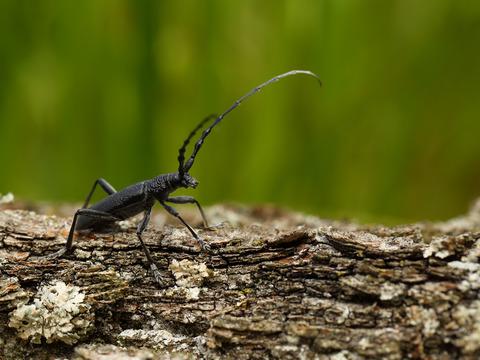当前位置:
X-MOL 学术
›
J. Appl. Ecol.
›
论文详情
Our official English website, www.x-mol.net, welcomes your
feedback! (Note: you will need to create a separate account there.)
Optimizing enrichment of deadwood for biodiversity by varying sun exposure and tree species: An experimental approach
Journal of Applied Ecology ( IF 5.0 ) Pub Date : 2020-04-28 , DOI: 10.1111/1365-2664.13648 Sebastian Vogel 1 , Martin M. Gossner 2 , Ulrich Mergner 3 , Jörg Müller 1 , Simon Thorn 1
中文翻译:

通过改变阳光和树木的种类来优化生物多样性的枯木资源:一种实验方法
更新日期:2020-04-28
Journal of Applied Ecology ( IF 5.0 ) Pub Date : 2020-04-28 , DOI: 10.1111/1365-2664.13648 Sebastian Vogel 1 , Martin M. Gossner 2 , Ulrich Mergner 3 , Jörg Müller 1 , Simon Thorn 1
Affiliation

|
- The enrichment of deadwood is essential for the conservation of saproxylic biodiversity in managed forests. However, existing strategies focus on a cost‐intensive increase of deadwood amount, while largely neglecting increasing deadwood diversity.
- Deadwood objects, that is logs and branches, from six tree species were experimentally sun exposed, canopy shaded and artificially shaded for 4 years, after which the alpha‐, beta‐ and gamma‐diversity of saproxylic beetles, wood‐inhabiting fungi and spiders were analysed. Analyses of beta‐diversity included the spatial distance between exposed deadwood objects. A random‐drawing procedure was used to identify the combination of tree species and sun exposure that yielded the highest gamma‐diversity at a minimum of exposed deadwood amount.
- In sun‐exposed plots, species numbers in logs were higher than in shaded plots for all taxa, while in branches we observed the opposite for saproxylic beetles. Tree species affected the species numbers only of saproxylic beetles and wood‐inhabiting fungi. The beta‐diversity of saproxylic beetles and wood‐inhabiting fungi among logs was influenced by sun exposure and tree species, but beta‐diversity of spiders by sun exposure only. For all saproxylic taxa recorded in logs, differences between communities increased with increasing spatial distance.
- A combination of canopy‐shaded Carpinus logs and sun‐exposed Populus logs resulted in the highest species numbers of all investigated saproxylic taxa among all possible combinations of tree species and sun‐exposure treatments.
- Synthesis and applications. We recommend incorporating the enrichment of different tree species and particularly the variation in sun exposure into existing strategies of deadwood enrichment. Based on the results of our study, we suggest to combine the logs of softwood broadleaf tree species (e.g. Carpinus, Populus), hardwood broadleaf tree species (e.g. Quercus) and coniferous tree species (e.g. Pinus) under different conditions of sun exposure and distribute them spatially in a landscape to maximize the beneficial effects on overall diversity.
中文翻译:

通过改变阳光和树木的种类来优化生物多样性的枯木资源:一种实验方法
- 阔叶林的丰富对于保护管理型森林中saproxylic生物多样性至关重要。但是,现有策略侧重于成本增加的沉木数量,而很大程度上忽略了不断增加的沉木多样性。
- 对来自6个树种的枯木物体(即原木和树枝)进行了实验,暴露在阳光下,遮盖了天篷,并人工遮蔽了4年,之后,将腐殖甲虫,居住真菌和蜘蛛的α,β和γ多样性分析。对β多样性的分析包括暴露的沉木物体之间的空间距离。随机抽取程序用于确定树木种类和阳光照射的组合,这些树木在最少暴露的枯木量下产生了最高的伽玛多样性。
- 在阳光暴晒的地块中,所有类群的原木种数均高于阴影地块,而在树枝中,鼠尾草甲虫则相反。树木物种仅影响saproxylic甲虫和居住木材的真菌的物种数量。原木之间的saproxy甲虫和栖木真菌的β多样性受阳光和树木种类的影响,但蜘蛛的β多样性仅受阳光的影响。对于原木中记录的所有七叶类类群,群落之间的差异随着空间距离的增加而增加。
- 在所有可能的树种和暴露处理组合中,冠层遮荫的Carpinus原木和暴露于阳光下的Populus原木的组合导致所有调查的Saproxylic分类群的物种数最高。
- 综合与应用。我们建议将丰富的不同树种(特别是阳光照射的变化)纳入现有的沉木富集策略中。根据我们的研究结果,我们建议在不同的阳光照射条件下,将软木阔叶树种(例如Carpinus,Populus),硬木阔叶树种(例如Quercus)和针叶树种(例如Pinus)的原木结合起来并分布在空间上将它们最大化地发挥作用,以最大程度地提高总体多样性。











































 京公网安备 11010802027423号
京公网安备 11010802027423号